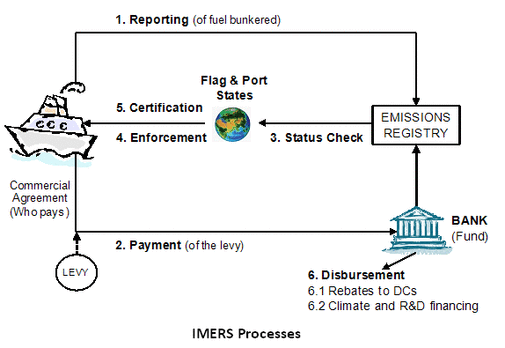IMERS (RM integrated)
This section describes the third generation of IMERS (also known as RM integrated, see Rebate Mechanism and MEPC 61).
IMERS in 30 words
A levy on fuel for international shipping with a rebate mechanism for developing countries. Applied worldwide, collected centrally - bypassing national coffers - raising US$10bn+ annually for climate change action.
Details
Under the proposed scheme a market-based levy is established on fuel bunkered (fuel delivered to a ship), as an alternative for a levy on CO2 emissions. The levy would apply to all ships over a predetermined size, engaged in international maritime transport, irrespective of their flag and nationality of the ship-owner. The liable entity in the scheme is a ship, uniquely identified by its IMO number.
Fuel bunkered in a given quarter must be electronically reported and is subject to payment of the constant levy for that quarter. The levy is obtained centrally, bypassing national coffers, and aggregated providing gross revenue for the scheme.
In order to deliver proportionality of the shipping effort to combating climate change, the levy is linked to a prevailing fee on land transport emissions, or to the rolling average market carbon price, as available. To increase price predictability the levy is set constant for a quarter, at least 30 days in advance of the start of each quarter. Thus the shipping industry would pay the most cost-effective price for its emissions and a fair one, in a simple manner.
In order to increase investment certainty, the levy is bounded by a predetermined price floor and ceiling, established for many years. These may be already defined implicitly through the price floor and ceiling of the carbon price the levy is linked to.
In order to maximize cost-efficiency, reduce the burden on the shipping industry, and guarantee a rapid deployment globally, a computer-based system and simple processes are defined.
The system is based on a central emissions registry (ER), holding an emission account for each ship, and a predetermined global bank (BK), or banks, providing a payment account for each ship, as shown in Fig. 2. The scheme operates through six processes (shown on Figure below):
- reporting of fuel bunkered, by ship (manager) to ER;
- payment of the levy, by ship (charterer) to BK, directly;
- status check of ship's compliance, by port and flag State control (PSC and FSC) with ER;
- enforcement of compliance, by PSC and FSC;
- certification of ship compliance, by FSC; and
- disbursement of revenue raised by BK and/or predetermined funds.

In order to comply with the UNFCCC principles and provisions, the rebate mechanism as introduced above applies, and is the first step of the disbursement process (6).
In summary, every developing country is entitled to obtain an unconditional payment (rebate). The rebate is calculated annually in proportion to a country’s share of global seaborne imports (attribution key) and the gross revenue raised. A developing country could voluntarily decide to forego the rebate, or a part of it, and record its decision.
More details
Scheme effectiveness, as well as how the scheme secure advantages to shipping and world trade are described below (follow the relevant navigation links).
